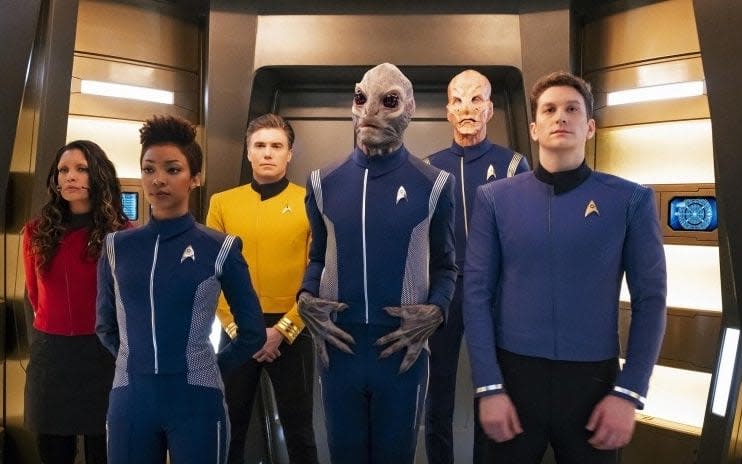Star Trek: Discovery, season 2 review: an enjoyable game of galactic join-the-dots

In 2017, Star Trek returned to the small screen in a dark, stylish reboot that felt far closer to a Hollywood blockbuster than to any of the previous TV versions.
The first series of Star Trek: Discovery (CBS/Netflix), set a decade before the events of the original Star Trek, was a single continuous story that barreled along at warp speed, boldly going in unexpected directions along the way. For instance, at the end of the second episode it killed off half the cast.
Series two might not have that dizzying ambition, but on the evidence of the first three episodes (in the 14-episode series) it's still never less than thoroughly enjoyable. This is largely due to the talents of its returning ensemble cast – although there's one glaring absence.
Jason Isaacs gave a magnetic performance in the last series as the untrustworthy, warmongering Captain Lorca. His death left a hole at the heart of the USS Discovery – and of Star Trek: Discovery itself, which now lacks a compelling antagonist.
As the second series opens, Lorca's empty chair is filled by Captain Pike (Anson Mount), who has hopped over from his regular post on the Enterprise, and tasks the Discovery's crew with investigating seven mysterious red dots that have appeared in far-flung corners of space.

The USS Discovery, of course, is uniquely well equipped for this long-haul exploration thanks to its "spore drive". In case you weren't paying attention last time, Pike neatly sums it up in a sentence: “This ship can skip across the universe on a highway made of mushrooms.”
There's something a little fishy about Pike, but not quite fishy enough. Mount does his best to hint that there's more to him than meets the eye, but through the first three episodes Pike remains a relatively bland character – at least compared to Lorca, or the rest of the Discovery's motley crew.
They're all two-dimensional in the best possible way, from fastidious First Officer Saru (Doug Jones, king of rubber-faced alien actors) to the simultaneously annoying and endearing Sylvia Tilly (Mary Wiseman), a junior crew member with the breathless enthusiasm of someone who's only there because she won a ComicCon competition.
Head and shoulders above the rest, though, is Anthony Rapp as Science Officer Stamets. He has been given an unreasonable amount of dramatic heavy-lifting, and carried it off with aplomb. First introduced as an irritable cynic, he underwent a complete personality change, attaining a zen-like calm after being given a glimpse of parallel universes by the spore drive. On top of all that, in season two he's also in mourning for his late boyfriend.

Rapp somehow manages to make all of this hang together in an affecting performance, keeping a straight face when delivering lines such as “Astro-mycology has taught me that nothing in the universe is ever truly gone.” It's a shame that Rapp is best known to many as Kevin Spacey's first accuser; in a parallel universe, he would have won an Emmy for this role and made headlines for that instead.
The real strength of the show is in its supporting performances – stand-up comic Tig Notaro has a brilliantly deadpan cameo in the second season's opening episode – and it's a testament to their scene-stealing that I haven't yet got around to mentioning the main character: Michael Burnham (the reliably good Sonequa Martin-Green).
A human raised by Vulcans, she is the estranged, adopted sister of Spock, who might just be the key to unravelling the mystery of the red glow, which has something to do with a "red angel" he once saw as a young boy. Unfortunately, Spock has disappeared without a trace – but perhaps following the red dots may lead Burnham to him.
And this, it seems, will be the thrust of the series, with the crew playing pan-galactic join-the-dots, beaming down onto a new planet each week, guided by those red beacons. It's comfortingly formulaic, in a way that feels like a return to the Star Trek of yore. Going where no TV show has ever gone before? Hardly. But it's good fun all the same.
The first episode of season two is available on Netflix UK from January 18; all of season one is available to stream now.